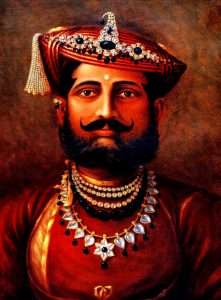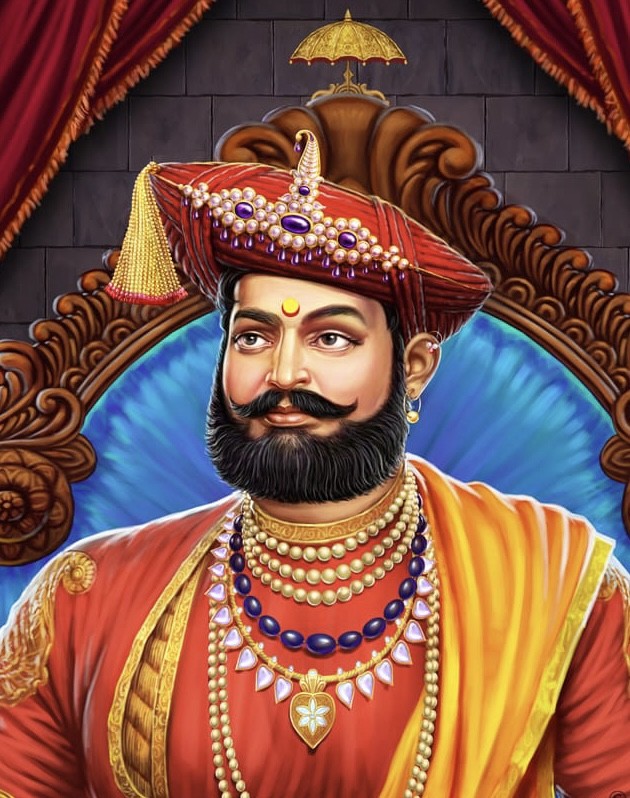Maharaja Yashwantrao Holkar was an expert in military skills & administered and established major branches of the army under his personal supervision. As a defense strategist, he ranks among the foremost generals who ever fought on Indian soil. His heroic achievements throw light on his military genius, political sagacity, and indefatigable brilliance. He is undoubtedly the greatest and most inspiring figure in recent world history due to his series of victories against Britishers, which was never seen in any colony of the English invasion. Yashwantrao was born in 1776. He was the son of Maharaja Tukojirao Holkar and grandson of Malhar Rao Holkar, who had regained Attock (now part of Pakistan) in 1758 and had hoisted the saffron flag beyond the Sindhu River.
Yashwantrao defeated the British army, led by Colonel Fawcett, at Kunch, in Budhlekand. On 8 June 1804, the Governor-General wrote that the defeat caused a great insult to General Gerard Lake. This would endanger the company rule in India, and hence Yashwantrao Holkar should be defeated as soon as possible. After a long time, a braveheart king showed decisive resistance to the British invasion, and they feared losing grip of India forever. No Hindu king or Muslim invader before Yashwantrao showed confrontation that was weakening British control. He was like a Hindu lion hunting down the English hyenas.
From June till September 1804, he defeated the British at different battles. British colonels were changing; Holkar was only common in these battles. His energy to fight the British made them awestruck and frightened. They were attacking from different places. On 22 August 1804, Wellesley marched against Holkar from Pune, along with Bajirao Peshwa’s army. In Mathura, Yashwantrao learned that the British had captured some of his territories; he decided to stay in Mathura and work out a strategy to regain his territory. In a letter dated 11 September 1804 written to Lord Lake, Wellesley said that if Yashwantrao Holkar was not defeated at the earliest, the rest of the Kings of India might unitedly stand against the British. On 8 October 1804, Yashwantrao attacked Delhi to free Muslim invader Shah Alam II, imprisoned by the British to strengthen his position. He attacked the army of Colonel Actorloni and Berne. The battle lasted for a week, but Yashwantrao Holkar could not succeed as General Lake came to help Colonel Actorloni. Assessing the situation, he changed the plan and postponed it. Admiring his bravery, Moghul Emperor Shah Alam gave him the title of “Maharajadhiraj Raj Rajeshwar Alija Bahadur.”
On 16 November 1804, Maharaja Yashwantrao Holkar reached Deeg by defeating the army of Major Frazer. After the death of Major Frazer, Manson took charge of the British army. The Jat King Ranjit Singh of Bharatpur welcomed him and decided to be with Yashwantrao against the British. In Farrukhabad, Lake became a mute spectator watching Yashwantrao proceeding towards Deeg; he didn’t dare attack Maharaja Yashwantrao. The Governor-General was disappointed by this conduct of Lord Lake, and he wrote to him about his disappointment. Lord Lake attacked Deeg on 13 December 1804, where the army of Holkar and Jat successfully resisted and reached Bharatpur. Lord Lake attacked on 3 January 1805, along with General Manson, Colonel Marey, Colonel Don, Colonel Berne, Major General Jones, General Smith, Colonel Jetland, Setan, and others. The subsequent siege of Bharatpur lasted for three months and was compared with the war described in the epic Mahabharat. Many poems on this war were written praising Yashwantrao.
Despite signing treaties and taking the help of several Hindu kings and Muslim invaders, Britishers could not harm the fearless warrior and his army. This supremacy of Yashwantrao not only shocked Britishers but also startled them.
The failure of General Lake to conquer the fort of Bharatpur shattered the myth of invincibility of British arms. It raised fears about the revival of the Maratha Confederacy against Wellesley’s wars of aggression in India. This came as an anti-climax to Wellesley’s ‘forward policy.’ Thus Wellesley was recalled, and Lord Cornwallis was appointed as the Governor-General of India. As soon as he came to India, he wrote to Lord Lake on 19 September 1805 and stated that all the territory of Yashwantrao will be returned and that he was ready to make peace with Holkar. Holkar refused to sign any treaty with the British. George Barlow was appointed as Governor-General due to the sudden death of Lord Cornwallis. Barlow immediately tried to divide Holkar and Scindia. The British signed a treaty with Daulatrao Scindia through Kamal Nayan Munshi on 23 November 1805, and in this way, Holkar was left alone to fight with the British.
British by then had realized that they would never be able to defeat brave Yashwantrao. Hence it was time to decimate his strength by invoking the DIVIDE-RULE policy. To divide the native kings, the British declared that they would distribute the territory of Holkars amongst its Indian friends. Amir Khan (Pindari) and Bhawani Shankar Khatri betrayed him. The British gave the Estate of Tonk to Amir Khan Pindari, and a Mahal and an Estate in Delhi were given to Bhawani Shankar Khatri. Bhawani Shankar Khatri’s Haweli, situated in Delhi, is referred to as Namak Haram ki Haweli (Traitors House). During his regime, the local people abandoned the place; they abused Khatri with cuss words and cursed him.
Yashwantrao Holkar, Daulatrao Scindia, Satara Chhatrapati, and Chatarsinh met at Sabalgad. It was decided that united; they would uproot the British from the Indian soil. Yashwantrao sent letters to the rest of the kings of India, appealing to them to fight against the British. He stated, “First Country, and then Nishtha. We will have to rise above Jaati, Nishtha, and our states in the interest of our country. You too must wage war against the British, like me.” The King of Jaipur, Bhosale of Nagpur, Ranjit Singh of Punjab, accepted his appeal. When the British learned that Holkar and Scindia were united, they informed Lake again to pursue them. On 25 April 1805, frightened Lord Lake replied to Governor-General Wellesley and stated that he could not pursue them as Holkar took great pleasure in killing the Europeans.
Though Daulatrao Scindia initially decided to help Holkar but was prevented from doing so by the ill advice of Kamal Nayan Munshi, who was a British stooge. Even Ranjit Singh later betrayed him. Yashwantrao cursed Ranjit Singh; this curse became a saying in Punjab. Any other king would have surrendered after series of betrayals from fellow Hindu kings, but Yashwantrao was truly a winner; he believed in himself, his army, his leadership skills, and Hindu pride. The dedication and belief alone made him half victorious before the battle was fought.
He was a man of self-respect. He was the only king in India whom the British approached with an unconditional peace treaty as per the London withdrawal policy. It was not a Treaty of Subsidiary alliance that the British had entered with others. Yashwantrao Holkar saw that the rest of the kings were not ready to unite and were interested in personal benefits. Eventually, he was the last to sign a treaty with the British on 24th December 1805 at Rajpur Ghat on the bank of Beas River. The treaty was named ‘The Treaty of Peace and Amity between the British Government and Yashwantrao Holkar.’ The British recognized him as a sovereign king, returned all his territories and possessions, and accepted his dominion over Jaipur, Udaypur, Kota, Bundi, and some Rajput kings. They also accepted that they would not interfere in the matters relating to Holkars. The treaty was duly ratified by Governor-General George Barlow in Council on 6 January 1806. Thus, he fulfilled his demands and successfully resolved the disputes with Shinde, Peshwa, and the British. The Victorious king reached Indore and started ruling his kingdom by declaring saving his ancestral State.
In a letter dated 15th February 1806 to Vyankoji Bhosale of Nagpur, he further states, “… Foreigners had grasped the Maratha state. To resist their aggression, I sacrificed everything during the last two and a half years, fighting night and day, without a moment’s rest. I paid a visit to Daulatrao Sindia and explained how necessary it was for all of us to join in averting foreign domination. But Daulatrao failed me. It was cooperation and goodwill which enabled our ancestors to build up the Hindu states. But now, we have all become self-seekers. You wrote that you were coming for my support, but you did not make your promise good. If you had advanced into Bengal as was planned, we could have paralyzed the British….” “It is no use of now talking of past things. When I found myself abandoned on all sides, I accepted the offer which the British agents brought to me and concluded the war.”
Lord Lake felt disgraced at these developments, resigned his post in protest, and returned to England. In a letter dated 14 March 1806 addressed to Mr. Sherer, Charles Metcalfe, who witnessed the treaty, states, “But why do I constantly harp upon the character of our Government? I believe it is because I am compelled to feel that we are disgraced; and that Holkar is the prevailing power in Hindustan.” Mr. Metcalfe, many years later looking back, admitted that the measures adopted by Sir George Barlow were necessitated, and it was hardly possible to have followed any other course.
However, Hindu Rashtra was a bigger dream than bogging down to the cunning politics of Britishers; Yashwantrao decided to stay in Bhanpura to gather a large army and manufacture cannons to defeat the British. He successfully kept the British out of his state, but he wanted them out of India. He knew that this was impossible without sufficient cannons, so he built a factory to manufacture cannons in Bhanpura. For this reason, he is also referred to as the “Father of Modern Indian Army.” He worked day and night and manufactured 200 short and long-range cannons. He gathered an army of 1 lakh soldiers to attack Calcutta. The stress of the work and the deaths of his nephew Khanderao Holkar on 22 February 1807 at Shahapura and Kashirao Holkar in 1808 at Bijagad lead to a stroke, from which he died at Bhanpura (Mandsaur, M.P.) on 27 October 1811 (Kartiki Ekadashi) at the young age of 35 years. The most probable cause of his death is due to excessive Blood Pressure and Stress.
Yashwantrao’s fearless valor and zeal made him King of kings in India. His battles were the most remarkable in the History of Indian Wars. The title given to him by the enemy Mughal Emperors gave him a prominent position amongst the rulers of India. There are numerous accounts shared by British and Mughal historians praising the bravery of Hindu Lion Yashwantrao Holkar.

Salute to the braveheart soldier!!
@ Yeshwant Marathe
